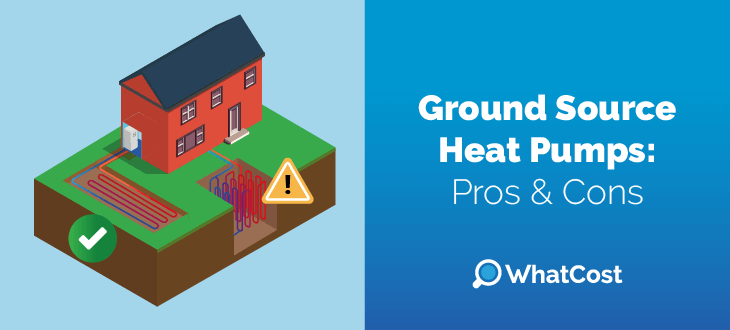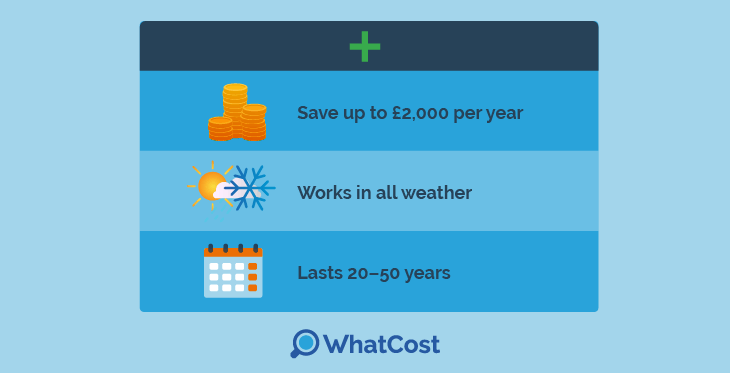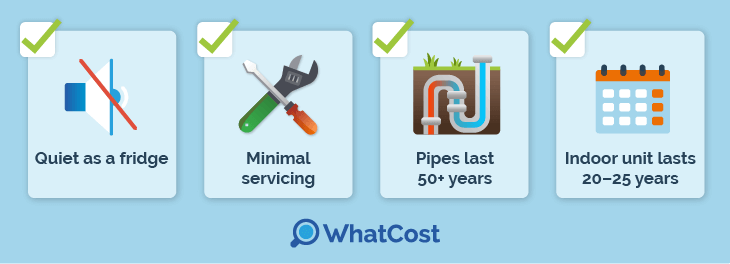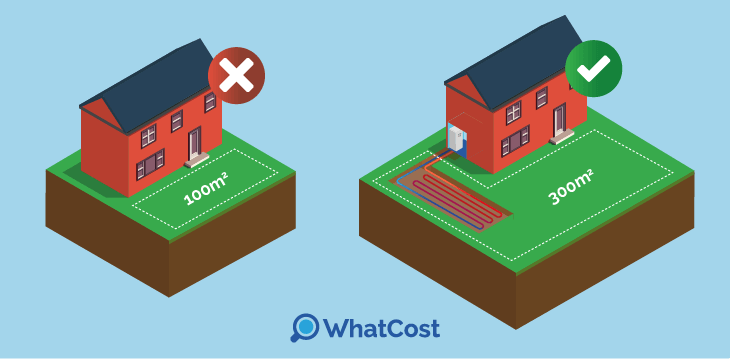Answer these simple questions and we will find you the BEST prices
Which type of solar quotes do you need?
It only takes 30 seconds
100% free with no obligation

Get up to 4 quotes by filling in only 1 quick form

Install a heat pump for less with the BUS grant

Increase the value of your home by installing a heat pump
- whatcost.co.uk
- Heat Pumps
- Ground Source
- Pros And Cons of Ground Source Heat Pumps
Pros And Cons of Ground Source Heat Pumps 2025


- Ground source heat pumps (GSHPs) can lower your heating bills by up to £2,000 per year. They produce 3 - 4 times more heat than the electricity they use.
- Installation costs are high, ranging from £15,500 to £26,500. The amount of space you have also matters. Horizontal layouts require at least 300 m² of garden space, while vertical boreholes take up less space but can add £5,500 to £7,000 to the final cost.
- Lasting over 25 years, this type of renewable system can deliver long-term energy savings. With up to £7,500 in government incentives and low running costs, it often works out cheaper than a boiler over time.
Many UK households are replacing old or unreliable heating systems. In our recent survey, over half of the respondents said poor performance was their main reason for upgrading. While ground source heat pumps in the UK have a higher upfront cost, they’re lower-maintenance and highly efficient, making them a strong long-term option.
This guide explains the key pros and cons, so you can decide if a ground source heat pump (GSPHs) suits your home and budget. If you’d rather skip the research yourself, our installer network can help. Over 70% of users in our recent survey said they were satisfied with the installer we matched them with.
That’s because we work with a wide network that installs a range of heat pumps in the UK, including ground source technology.
Use our quick 30-second form to check current prices near you. It’s free, fast, saves hours of research, and there’s no pressure to commit.
- Quotes from local installers
- Payment by finance available
- Save £7,500 with BUS grant
It only takes 30 seconds

What is a ground source heat pump and how does it work?
A ground source heat pump (GSHP) uses natural underground warmth to heat your home and hot water. It consists of three main parts: a buried pipe system, known as a ground loop, an indoor heat pump unit, and a heat distribution system, such as radiators or underfloor heating.
The pipes can be laid out in horizontal trenches, which require around 300 m² of outdoor space, or installed in vertical boreholes. These take up less space above ground but are more expensive due to the deeper drilling. The right layout depends on your available space and budget.
These setups are ideal for homes with outdoor space and work well across most parts of the UK. Here’s how they operate, step by step:
Step 1: Laying the pipes and installing the system
A trained installer professionally buries a network of pipes in your garden. These can be installed in shallow trenches (horizontal system) or drilled deep into boreholes (vertical system), depending on the available space.
Once the pipework is in place, it is filled with a water and antifreeze mixture (such as Kilfrost GEO or Sentinel R500C) to avoid freezing. The network is then connected to an indoor heat pump unit.
Step 2: Capturing heat from the ground
As the antifreeze fluid flows through the buried pipes, it collects natural warmth from the surrounding soil or bedrock. The ground temperature stays around 10 °c all year, so the system can operate continuously, even in colder months.
Step 3: Raising the temperature indoors
Inside the pump, a heat-sensitive fluid (called a refrigerant) captures the absorbed heat and turns it into a gas. The pump compresses this gas, raising its temperature so it’s hot enough for your home’s heating and hot water.
Step 4: Delivering heat to your house
The heated gas moves its warmth to your radiators, underfloor pipes, and hot water tank. Once the heat is released, the fluid cools down and returns to the underground pipes to start the cycle again.
Want to compare installing an air source system with a ground source system? Our guide on installing a heat pump explains the full installation process, costs, and timeline for air source heat pumps in the UK.
Ground source heat pump advantages

Ground source systems offer reliable heating, low running costs, and long-term value, especially if you qualify for a government grant. Here are some top reasons why ground source systems are beneficial for UK homeowners.
You can save hundreds of pounds on heating bills
These systems can cut up to £2,000 off your annual heating cost, especially if you currently use oil, LPG, or electric heaters. On average, they produce 3 to 4 units of heat for every unit of electricity used. This efficiency means you use far less energy to heat your home. But how much you save depends on your current system.
- For a typical 3-bedroom home, switching from oil, LPG, or electric heaters to ground source systems could save you between £90 and £2,000 per year.
- If you use electric storage heaters, your heating costs could drop up to 45% per year.
- If you use a gas boiler, the savings may be smaller, but still worthwhile, especially if you are replacing an old or inefficient boiler.
They perform in all weather
Because the underground temperatures remain near 10°c throughout the year, these systems operate reliably even in winter. This makes them more consistent when compared to other technologies, like ground source heat pump vs air source system. That’s because air source models rely on outside air, which gets much colder in winter and can affect heating output.
It runs quietly and needs little maintenance

Ground source heat pumps run quietly because there’s no need for a large outdoor fan. Unlike air source models, they operate as quietly as a fridge or modern boiler, according to the Energy Saving Trust.
Maintenance needs are also minimal. With fewer moving parts and no combustion involved, there’s less to service over time. If installed correctly, the ground loop (underground pipes) can last over 50 years, according to the International Energy Agency. These loops are made from tough, high-density polyethylene (HDPE) materials to withstand decades of use and various environmental factors, such as high acidity or certain chemical contaminants in the soil.
Indoors, the unit usually lasts 20 to 25 years, often outliving air-based alternatives, which can last 15 to 20 years. In most homes, a routine check is all that’s needed to keep it running efficiently.
You can apply for a government grant
If the upfront cost feels too high, you may qualify for a heat pump grant to help cover part of it. These grants are available across the UK and can reduce the cost of ground source heat pump installation for eligible households.
- £7,500 Boiler Upgrade Scheme (England & Wales)
- Up to £15,000 (loan + grant) in Scotland via Home Energy Scotland
- Northern Ireland Sustainable Energy Programme (NISEP) in Northern Ireland, depending on availability.
These funding schemes make ground source systems more accessible, especially if you already use electric, oil or LPG heating.
Together, these advantages make ground source systems one of the most efficient and future-ready heating options for UK homes.
If you’re considering one, the first step is to get a ground source heat pump quote. Comparing options helps you understand the likely cost for your property and check if this setup works with your home’s layout.
Fill in the form below to get up to 4 free non-commitment quotes from our qualified UK installer network. All in under a minute.
- Quotes from local installers
- Payment by finance available
- Save £7,500 with BUS grant
It only takes 30 seconds

Ground source heat pump disadvantages

With all the benefits of a ground source system, there are still some drawbacks to consider. Below, we explain each disadvantage.
The system is expensive to install
One of the biggest barriers is cost. The ground source heat pump cost in the UK falls between £15,000 and £30,000 in 2025, depending on your home’s size, whether you install a horizontal loop or opt for deeper boreholes.
Take, for example:
- A well-insulated 3-bedroom home may need a full system, including the indoor unit, underground pipework, and installation, totalling around £18,000.
- Even with the £7,500 Boiler Upgrade Scheme, bringing the total closer to £10,500, the upfront spend remains a major consideration for many households.
Require outdoor space

This type of heat pump uses underground pipes to collect heat from the earth, so it needs garden space or an outdoor area. For instance:
- A horizontal system needs at least 300 square metres of outdoor space for a standard 3 to 4-bedroom detached home.
- If space is limited, a ground source heat pump borehole system is often used instead. These vertical systems drill deep holes (between 50 and 150 metres) into the earth to install the pipes. Borehole installation can add £6,000 to £7,000 to the total cost for a mid-sized home, due to deeper excavation and specialist equipment required.
Not suitable for all homes
Some homes are not a fit for ground source systems due to space or layout. For instance:
- Homes without a private garden, such as flats or mid-terraces, may not have enough space to install the underground loop.
- Indoors, the setup requires space for the heat pump unit, a hot water cylinder, and, optionally, a buffer tank for underfloor heating. Together, these components can take up the space of a tall cupboard or a small utility room.
- The system also works best in well-insulated homes. If your property loses heat quickly through its walls, roof, or windows, efficiency drops, and running costs may increase.
Essentially, if your home has limited space or low insulation levels, an air source heat pump or another system with a smaller heat pump size might be a better option.
May need upgrades or permission
For the best results, your heat pump may require upgrades, such as larger radiators, a new hot water cylinder, or optional underfloor heating.
Planning permission isn’t usually required. But if your home is listed or in a conservation area, you must check with your local authority first.
Should I get a ground source heat pump for my home?
Yes, if your home has enough outdoor space and good insulation, a ground source heat pump can be one of the most efficient and low-maintenance ways to heat your home in the UK.
It’s a strong long-term option if you currently rely on electric, oil, or LPG heating, and have high energy bills. These systems work best in well-insulated properties and are ideal for households planning to stay in their homes for many years.
That said, it may not be suitable if your property lacks outdoor space, room for the indoor units, or requires major insulation upgrades.
If you’re ready to explore your options, the easiest next step is to request a free quote. It takes less than a minute and connects you with a qualified local installer from our UK-wide network.
Get your quote now to see how much a ground source heat pump would cost for your home. With potential savings of up to £2,000 on your heating bills and grants worth £7,500 (England & Wales), it could pay for itself over time, especially if your current system is costly to run.
It’s quick, free, and there’s no pressure. You can compare up to 4 installer quotes before deciding. Click below to get started.
- Quotes from local installers
- Payment by finance available
- Save £7,500 with BUS grant
It only takes 30 seconds

FAQ
The main disadvantages of ground source heat pumps include high upfront costs, the need for outdoor space to install pipework or boreholes, and possible upgrades like underfloor heating or radiators. Also, these systems may not suit smaller or poorly insulated homes.
Yes, a ground source heat pump is often worth it if your home is suitable. It offers low running costs, high heating output, and long-term savings, especially if your current systems are oil or electric and qualify for a heat pump grant.
The main benefits of ground source systems are low running costs, consistent heating in all weather, and minimal upkeep. They use less energy than traditional boilers and run quietly. The indoor unit can last 20 – 25 years, and the underground loop can last over 50 years.

Rousanna is an SEO content writer at WhatCost with a background in digital marketing and copywriting. She creates informative, well-researched home improvement content based on practical ideas to help readers make informed decisions.
- Quotes from local installers
- Payment by finance available
- Save £7,500 with BUS grant
It only takes 30 seconds

